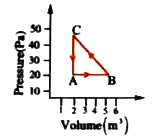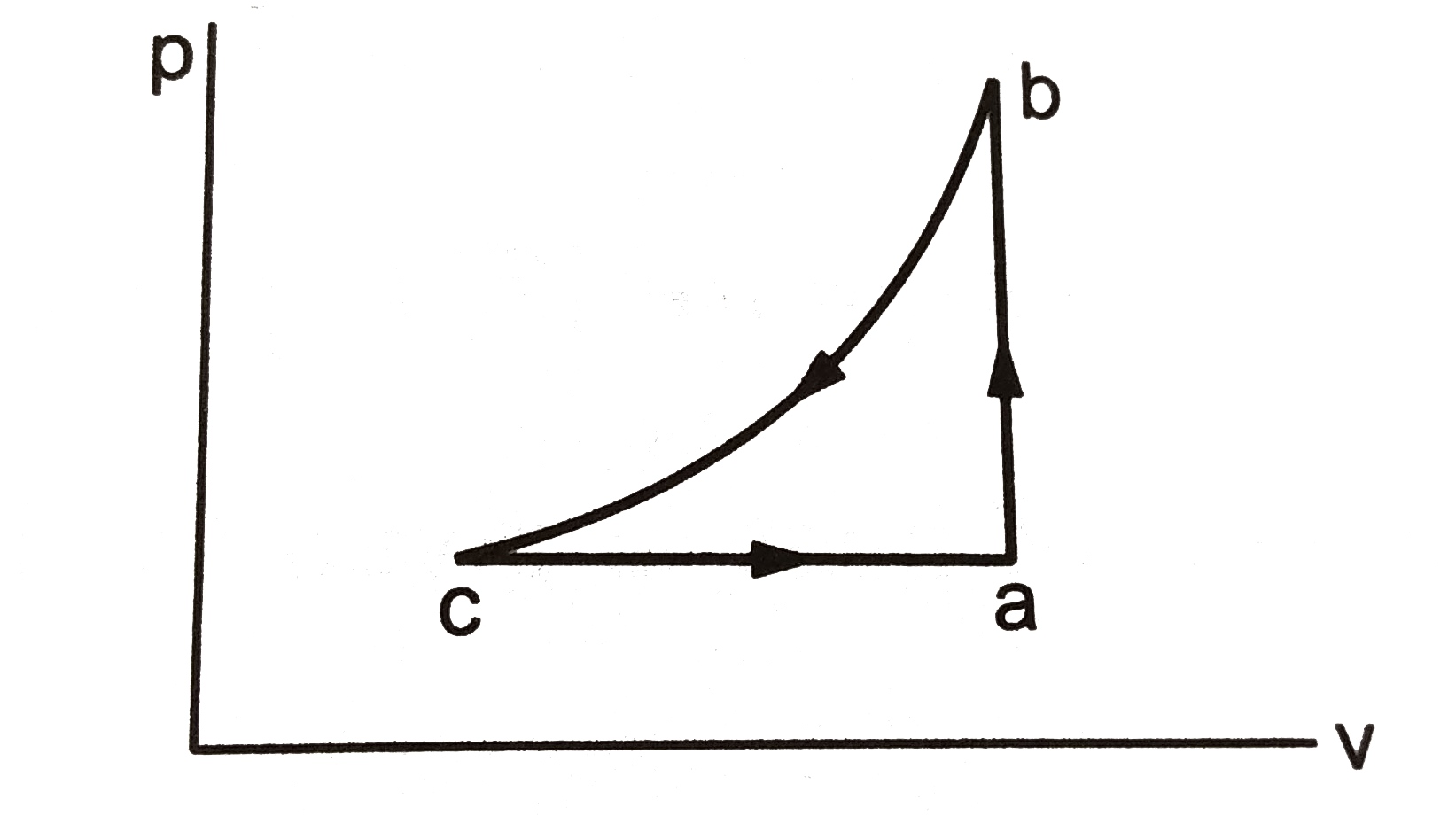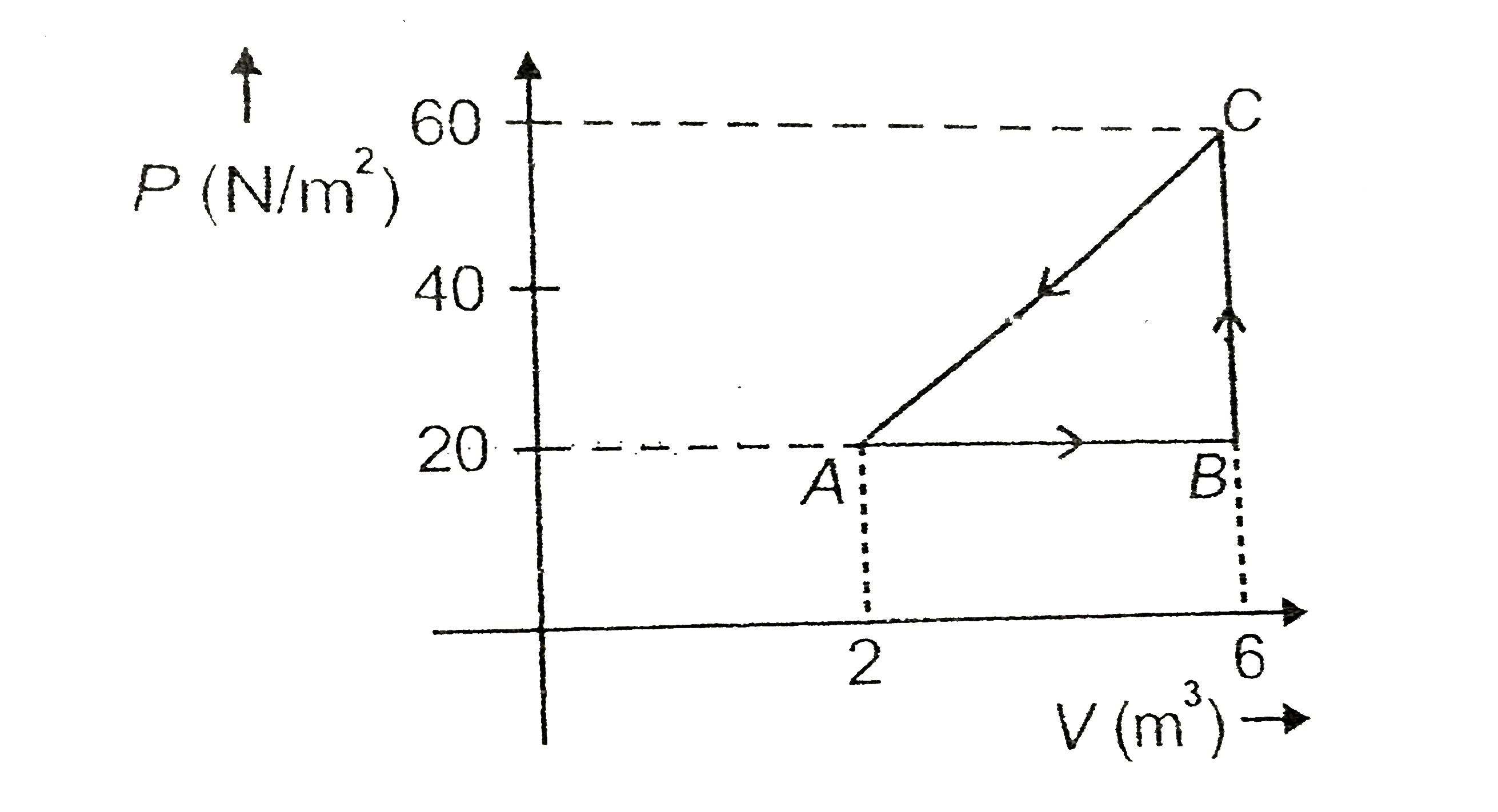Figure depicts the working diagram (P-V graph) of a process corresponding to an ideal gas. Suppose UA=10J,UB=50J and heat given to the gas during the process BC is 40 J. Determine

Internal energy of the gas in the state C. Solution in Telugu
Work done by the gas during the process
BC = Area below the graph =−12(20+50)Nm2×(6−2)m3=−140J
Now, applying first law of thermodynamics to the process BC,
ΔQ=ΔU+ΔW
40J=ΔU+(−140J)
∴ΔU=180J
i.e., (Uc−50J)=180J,orUc=230J
Topper's Solved these Questions
- BOOK - AAKASH SERIESCHAPTER - THERMODYNAMICSEXERCISE - TEST YOUR SELF17videos
THERMODYNAMICS
- BOOK - AAKASH SERIESCHAPTER - THERMODYNAMICSEXERCISE - SHORT ANSWER TYPE QUESTIONS8videos
THERMODYNAMICS
- BOOK - AAKASH SERIESCHAPTER - THERMODYNAMICSEXERCISE - ADDITIONAL PRACTICE EXERCISE (PRACTICE SHEET ((ADVANCED) INTEGER/SUBJECTIVE TYPE QUESTIONS))11videos
THERMODYNAMICS
- BOOK - AAKASH SERIESCHAPTER - THERMAL PROPERTIES OF MATTEREXERCISE - ADDITIONAL PRACTICE EXERCISE (LEVEL - II) PRACTICE SHEET (ADVANCED) Integer/Subjective Type Questions2videos
THERMAL PROPERTIES OF MATTER
- BOOK - AAKASH SERIESCHAPTER - THERMOMETRY EXERCISE - Numerical Exercise (LEVEL- 1)11videos
THERMOMETRY
Similar Questions
Should a quais-static process be reversible?
05:11View SolutionDefine two principal specific heats of a gas . Which is greater and why ?
01:19View SolutionA cylinder of ideal gas is closed by an 8 kg movable piston of area 60cm2 . The atmospheric pressure is 100 kPa. When the gas is heated from 30∘C to 100∘C the piston rises 20 cm. The piston is then fastened in the place and the gas is cooled back to 30∘C. If ΔQ1 is the heat added to the gas during heating and ΔQ2 is the heat lost during lost cooling, find the difference.
02:22View SolutionA constant pressure gas thermometer has a volume of 200cc, 273.2cc and 525 .1cc at 0°C, 100°C and boiling point of sulphur respectively. The resistance possessed by a platinum wire at the same temperatures as above are 2.000Ω,2.778Ωand5.280Ω respectively. Estimate the boiling point of sulphur on the basis of the two sets of observations.
08:38View SolutionIf a temperature scale defines the freezing point of water as 100∘C and the boiling as 0∘ what temperature on the scale corresponds to 25∘ C ?
05:51View SolutionA sample of an ideal gas is taken through the cyclic process abca . It absorbs 50 J of heat during the part ab, no heat during bc and rejects 70 J of heat during ca. 40 J of work is done on the gas during the part bc.(a) find the internal energy of the gas at b and c if it is 1500 J at a. (b) calculate the work done by the gas during the part ca.
 04:29View Solution
04:29View SolutionIn isobaric process of ideal gas (f=5) work done by gas is equal of 10J. Then heat given to gas during process:
07:49View SolutionMethod 2 of Q In a given process work done on a gas is 40 J and increases in its internal energy is 10J. Find heat given or taken to/from the gas in this process.
05:42View Solutionp-V diagram of an ideal gas for a process ABC is as shown in the figure. (a) Find total heat absorbed or released by the gas during the process ABC. (b) Change in internal energy of the gas during the process ABC. (c) Plot pressure versus density graph of the gas for the process ABC.
02:04View SolutionAn ideal gas is taken round a cyclci thermodynamic process ABCA as shown if Fig. If the internal energy of the gas at point A is assumed zero while at B it is 50 J. The heat absorbed by the gas in the process BC is 90 J. (a) What is the internal energy og the gas at point C ? (b) How much heat energy is absorbed by the gas in the process AB? (c ) Find the heat energy rejected or absorbed by the gas in the process CA. (d) What is the net work done by the gas in the complete cycle ABCA ?
04:17View SolutionA sample of an ideal gas in taken through the cyclic process abca in the given figure. It absorbs 50 J of heat during the parth ab, no heat during bc and rejects 70J of heat during ca, 40 J of work is done on the gas during the part bc. (a) Find the internal energy of the gas at b adn c if it is 1500 J at a. ltbr> (b) Calculate the work done by the gas during the part ca.
02:27View SolutionAn ideal gas follows a cyclic process as shown in figure. Internal energy of gas at point A is 10 J while at B is 70 J. the heat absorbed by gas in BC is 120 J.

(a) How much heat is absorbed in process AB?
(b) Find heat energy rejected or absorbed by gas in process CA.02:53View SolutionA sample of an ideal gas is taken through the cyclic process abca . It absorbs 50 J of heat during the part ab, no heat during bc and rejects 70 J of heat during ca. 40 J of work is done on the gas during the part bc.(a) find the internal energy of the gas at b and c if it is 1500 J at a. (b) calculate the work done by the gas during the part ca.
 View Solution
View SolutionIn isobaric process of ideal gas (f=5) work done by gas is equal of 10J . Then heat given to gas during process:
01:13View SolutionFigure depicts the working diagram (P-V graph) of a process corresponding to an ideal gas. Suppose U_A=10J, U_B = 50 J and heat given to the gas during the process BC is 40 J. Determine heat extracted from the system in going from C to A
05:04View Solution

